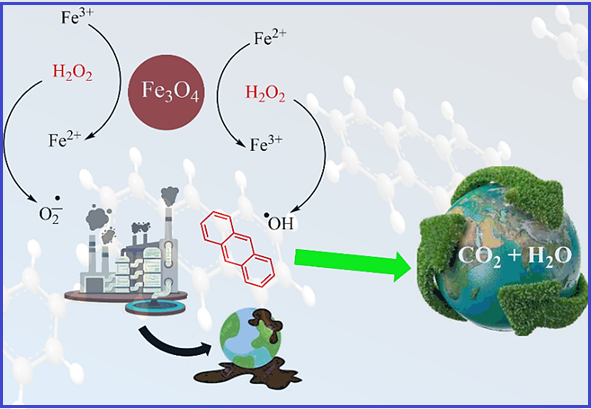A novel modified fenton-like process for efficient remediation of anthracene-contaminated soils before analysis by ultraviolet–visible spectroscopy
Volume 4, Issue 03, Pages 47-58, Sep 2021 *** Field: Nano Environmental Chemistry
Abstract
Due to the persistence of polycyclic aromatic hydrocarbons (PAHs) in soil and sediments, and their toxic, mutagenic, and carcinogenic effects, the remediation of PAH-contaminated sites is an important role for environment pollution. In this study, the chemical oxidative remediation of anthracene-contaminated soils was investigated by magnetite nanoparticles (Fe3O4) catalyzed Fenton-like oxidation in the presence of hydrogen peroxide 30% (H2O2) and urea-hydrogen peroxide (UHP) at neutral pH. Urea-hydrogen peroxide (UHP), as a safer oxidizing agent, is used for the first time in the Fenton process. The magnetite nanoparticles improved the production of hydroxyl radicals, and the removal of polycyclic aromatic hydrocarbons (anthracene as a model compound) from the soil samples. The structure of Fe3O4 nanoparticles was characterized by FT-IR, XRD, SEM, and vibrating sample magnetometer (VSM). The removal efficiency of anthracene at an initial concentration 2500 (mg kg-1) was 95% for 2.5 mmol by using hydrogen peroxide and 93% for 0.1 mmol of UHP at the optimum oxidation condition. The anthracene reaction was analyzed by ultraviolet-visible spectroscopy (UV-Vis). The UHP safety and efficiency, neutral pH condition, the limited iron leaching and its easy magnetic separation makes magnetite nanoparticles-UHP a promising catalytic system in remediation of polycyclic aromatic hydrocarbons in contaminated soils.
References
L. Wu, R. Sun, Y. Li, C. Sun, Sample preparation and analytical methods for polycyclic aromatic hydrocarbons in sediment, Trends Environ. Anal. Chem., 24 (2019) e00074.
Y. Sun, S. Wu, G. Gong, Trends of research on polycyclic aromatic hydrocarbons in food: A 20-year perspective from 1997 to 2017, Trends food sci. technol., 83 (2019) 86-98.
H.K. Bojes, P.G. Pope, Characterization of EPA’s 16 priority pollutant polycyclic aromatic hydrocarbons (PAHs) in tank bottom solids and associated contaminated soils at oil exploration and production sites in Texas, Regul. Toxicol. Pharmacol.. 47 (2007) 288–295.
X.P. Yang, L.X. Xie, J. Tang, J. Lin, Removal and degradation of phenanthrene and pyrene from soil by coupling surfactant washing with photocatalysis, Appl. Mech. Mater., 446 (2014) 1485–1489.
S. Kuppusamy, P. Thavamani, K. Venkateswarlu, Y.B. Lee, R. Naidu, M. Megharaj, Remediation approaches for polycyclic aromatic hydrocarbons (PAHs) contaminated soils: Technological constraints, Emerg. trends Future Directions, 168 (2017) 944-968.
M. Usman, P. Faure, K. Hanna, M. Abdelmoula, C. Ruby, Application of magnetite catalyzed chemical oxidation (Fenton-like and persulfate) for the remediation of oil hydrocarbon contamination,Fuel., 96 (2012) 270–276.
R. Andreozzi, V. Caprio, A. Insola, R. Marotta, Advanced oxidation processes (AOP) for water purification and recovery, Catal. Today, 53 (1999) 51–59.
Q. Zhou, Y. Wang, J. Xiao, H. Fan, C. Chen, Preparation and characterization of magnetic nanomaterial and its application for removal of polycyclic aromatic hydrocarbons, J. Hazard. Mater., 371 (2019) 323–331.
A. Romero, A. Santos, F. Vicente, S. Rodriguez, A.L. Lafuente, In situ oxidation remediation technologies: Kinetic of hydrogen peroxide decomposition on soil organic matter, J. Hazard. Mater., 170 (2009) 627–632.
J. Shao, F. Lin, Z. Wang, P. Liu, H. Tang, Y. He, K. Cen, Low temperature catalytic ozonation of toluene in flue gas over Mn-based catalysts: Effect of support property and SO2/water vapor addition, Appl. Catal. B: Environ., 266 (2020) 118662.
C.M. Kao, K.D. Huang, J.Y. Wang, T.Y. Chen, H.Y. Chien, Application of potassium permanganate as an oxidant for in situ oxidation of trichloroethylene-contaminated groundwater: A laboratory and kinetics study, J. Hazard. Mater., 153 (2008) 919–927.
J.A. Khan, X. He, H.M. Khan, N.S. Shah, D.D. Dionysiou, Oxidative degradation of atrazine in aqueous solution by UV/H2O2/Fe2+, UV/S2O82-/Fe2+ and UV/HSO5-/Fe2+ processes: A comparative study, Chem. Eng. J., 218 (2013) 376–383.
K. Ayoub, E.D. van Hullebusch, M. Cassir, A. Bermond, Application of advanced oxidation processes for TNT removal: A review, J. Hazard. Mater., 178 (2010) 10-28.
M. Bellardita, V. Loddo, A. Mele, W. Panzeri, F. Parrino, I. Pibiri, L. Palmisano, Photocatalysis in dimethyl carbonate green solvent: Degradation and partial oxidation of phenanthrene on supported TiO2, RSC Adv., 4 (2014) 40859–40864.
M. Ruokolainen, T. Gul, H. Permentier, T. Sikanen, R. Kostiainen, T. Kotiaho, Comparison of TiO2 photocatalysis, electrochemically assisted Fenton reaction and direct electrochemistry for simulation of phase i metabolism reactions of drugs, Eur. J. Pharm. Sci., 83 (2016) 36–44.
S.N. Malik, P.C. Ghosh, A.N. Vaidya, S.N. Mudliar, Hybrid ozonation process for industrial wastewater treatment: Principles and applications: A review, j. Water Process Eng., 35 (2020) 101193.
K. Ayoub, E.D. Van Hullebusch, M. Cassir, A. Bermond, Application of advanced oxidation processes for TNT removal: A review, J. Hazard. Mater., 178 (2010) 10–28.
M.D. Nicodemos Ramos, L.A. Sousa, A. Aguiar, Effect of cysteine using Fenton processes on decolorizing different dyes: a kinetic study, Environ. Technol., 57 (2020) 1–132.
C.M. Dominguez, A. Romero, A. Santos, Selective removal of chlorinated organic compounds from lindane wastes by combination of nonionic surfactant soil flushing and Fenton oxidation, Chem. Eng. J., 376 (2019) 120009.
C.G.S. Lima, N.M. Moreira, M.W. Paixão, A.G. Corrêa, Heterogenous green catalysis: Application of zeolites on multicomponent reactions, Curr. Opin. Green Sustain. Chem., 15 (2019) 1-7.
P.T. Silva, V.L. da Silva, B. de B. Neto, M.O. Simonnot, Phenanthrene and pyrene oxidation in contaminated soils using Fenton’s reagent, J. Hazard. Mater., 161 (2009) 967–973.
F. Pardo, M. Peluffo, A. Santos, A. Romero, Optimization of the application of the Fenton chemistry for the remediation of a contaminated soil with polycyclic aromatic hydrocarbons, J. Chem. Technol. Biotechnol., 91 (2016) 1763–1772.
G. Vilardi, D. Sebastiani, S. Miliziano, N. Verdone, L. Di Palma, Heterogeneous nZVI-induced Fenton oxidation process to enhance biodegradability of excavation by-products, Chem. Eng. J., 335 (2018) 309–320.
E.G. Garrido-Ramírez, B.K.G. Theng, M.L. Mora, Clays and oxide minerals as catalysts and nanocatalysts in Fenton-like reactions - A review, Appl. Clay Sci., 47 (2010) 182–192.
Y. Wang, Y. Gao, L. Chen, H. Zhang, Goethite as an efficient heterogeneous Fenton catalyst for the degradation of methyl orange, Catal. Today, 252 (2015) 107–112.
M. Lu, Z. Zhang, W. Qiao, Y. Guan, M. Xiao, C. Peng, Removal of residual contaminants in petroleum-contaminated soil by Fenton-like oxidation, J. Hazard. Mater., 179 (2010) 604–611.
M. Munoz, Z.M. de Pedro, J.A. Casas, J.J. Rodriguez, Preparation of magnetite-based catalysts and their application in heterogeneous Fenton oxidation - A review, Appl. Catal. B: Environ., 176 (2015) 249-265.
S. Rostamnia, B. Gholipour, X. Liu, Y. Wang, H. Arandiyan, NH2-coordinately immobilized tris(8-quinolinolato)iron onto the silica coated magnetite nanoparticle: Fe3O4@SiO2-FeQ3 as a selective Fenton-like catalyst for clean oxidation of sulfides, J. Colloid Interface Sci., 511 (2018) 447–455.
H.Y. Xu, B. Li, T.N. Shi, Y. Wang, S. Komarneni, Nanoparticles of magnetite anchored onto few-layer graphene: A highly efficient Fenton-like nanocomposite catalyst, J. Colloid Interface Sci., 532 (2018) 161–170.
C.H. Han, H.D. Park, S.B. Kim, V. Yargeau, J.W. Choi, S.H. Lee, J.A. Park, Oxidation of tetracycline and oxytetracycline for the photo-Fenton process: Their transformation products and toxicity assessment, Water Res., 172 (2020) 115514.
S.S. Li, Z. Tian, D.Z. Tian, L. Fang, Y.W. Huang, J. Xu, Preparation and Surface Modification of Magnetic Fe3O4 Nanoparticles, Adv. Sci. Eng. Med., 12 (2020) 131–136.
W. Mäntele, E. Deniz, UV–VIS absorption spectroscopy: Lambert-Beer reloaded, Spectrochim. Acta Part A: Mol. Biomol. Spec., 173 (2017) 965–968.
V.C. Mora, L. Madueño, M. Peluffo, J.A. Rosso, M.T. Del Panno, L.S. Morelli, Remediation of phenanthrene-contaminated soil by simultaneous persulfate chemical oxidation and biodegradation processes, Environ. Sci. Pollut. Res., 21 (2014) 7548–7556.
Z. Najahi Mohammadizadeh, M. Hamidinasab, N. Ahadi, M.A. Bodaghifard, A novel hybrid organic-inorganic nanomaterial: preparation, characterization and application in synthesis of diverse heterocycles, Polycycl. Aromat. Compd., (2020). https://doi.org/10.1080/10406638.2020.1776346

JOURNAL PUBLISHING AGREEMENT
PLEASE PROVIDE US THE FOLLOWING INFORMATION,
Article entitled:
Corresponding author:
To be published in the journal:
Your Status
I am the sole author of the manuscript
- I am an Iranian government employee.
- I am a European government employee
- I am a Asian government
- None of the above
I am one author signing on behalf of all co-authors of the manuscript
- I am an Iranian government employee.
- I am a European government employee
- I am a Asian government
- None of the above
Please tick the above blanks (as appropriate), review the Journal Publishing Agreement, and then sign and date the document in black ink.
Published Journal Article: the author may share a link to the formal publication through the relevant DOI. Additionally theses and dissertations which contain embedded Published Journal Articles as part of the formal submission may be hosted publicly by the awarding institution with a link to the formal publication through the relevant DOI. Any other sharing of Published Journal Articles is by agreement with the publisher only.
Signed: ______________________________________ Name printed: ___________________________________________
Title and Company (if employer representative): _______________________Date: __________________________________














